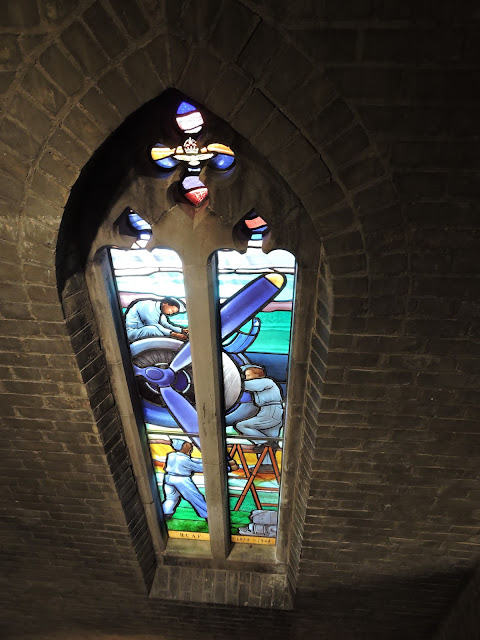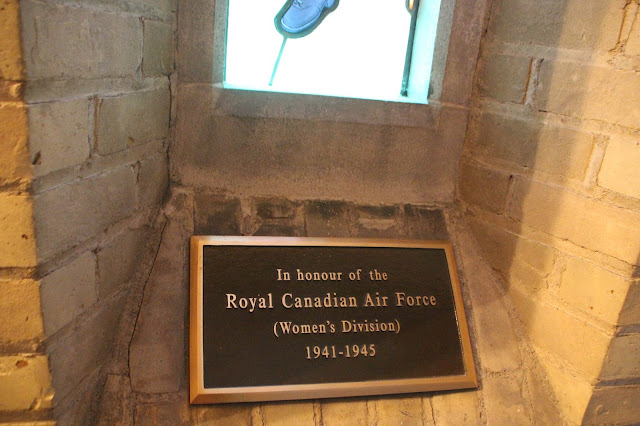I found most of the information about the tower at the University of Toronto Alumni Association.
Soldiers' Tower is a bell and clock tower at the University of Toronto that commemorates members of the university who served in the World Wars. Designed by architects Henry Sproatt and Ernest Ross Rolph, the Gothic Revival tower stands at 143 feet (43.6 m) tall and houses a carillon of 51 bells. The University of Toronto is the only Canadian university with a functioning carillon.
As you climb the rather narrow staircase there are 8 small stained-glass windows that depict men and women of the armed forces at wartime.
The tower features a dramatic 12-panel stained-glass window that is partly a visual interpretation of John McCrae's "In Flanders Fields". Every school child of my generation memorized this poem and can probably still recite it.
This stained glass is magnificent.
Details of the panels.
A museum within the tower showcases a collection of medals, memorial books, portraits, photographs, flags and miscellaneous memorabilia from the period.
......
On the right:
Sir Frederick Banting
Banting was thirty-one in 1923 when he received the Nobel Prize for Medicine along with J. J. R. Macleod, Charles Best, and J. B. Collip. After service as a doctor in Flanders in The Great War, he tried general practice in London, Ontario, without much satisfaction; however, he was intrigued by the relationship between the pancreas and diabetes. His consequent experiments at the University of Toronto led to the discovery of insulin and an effective method of controlling diabetes. Fishing and painting were two outside activities he enjoyed. Some of his happiest times were on sketching trips with A. Y. Jackson. An intensely patriotic man, when the Second World War came, Banting threw himself into war work, and was on his way to England on a secret mission when he was killed in 1941 in a plane crash in Newfoundland.
Sir Frederick Banting
Banting was thirty-one in 1923 when he received the Nobel Prize for Medicine along with J. J. R. Macleod, Charles Best, and J. B. Collip. After service as a doctor in Flanders in The Great War, he tried general practice in London, Ontario, without much satisfaction; however, he was intrigued by the relationship between the pancreas and diabetes. His consequent experiments at the University of Toronto led to the discovery of insulin and an effective method of controlling diabetes. Fishing and painting were two outside activities he enjoyed. Some of his happiest times were on sketching trips with A. Y. Jackson. An intensely patriotic man, when the Second World War came, Banting threw himself into war work, and was on his way to England on a secret mission when he was killed in 1941 in a plane crash in Newfoundland.
On the left:
Major Fred Tilston VC
Awarded the Victoria Cross for his persistent courage and outstanding leadership, despite serious wounds, in the critical battle to clear the Hochwald Forest (Germany), March 1, 1945. With the Company reduced to one quarter strength and the enemy repeatedly counterattacking, Major Tilston moved in the open, organizing defence and inspiring his men to hold firm against great odds. He repeatedly crossed ground dominated by intense fire from enemy machine-gun posts to carry ammunition to his troops.
A graduate in Pharmacy from the University of Toronto in 1929, he entered business and became sales manager of the Bayer Company by 1936. He enlisted in 1939, went overseas in 1941, and landed in Normandy soon after D Day. After the war, he rose to become President, and CEO of Sterling Drugs Ltd. By overcoming the loss of both legs and an eye he became an inspiration to young and old.
Major Fred Tilston VC
Awarded the Victoria Cross for his persistent courage and outstanding leadership, despite serious wounds, in the critical battle to clear the Hochwald Forest (Germany), March 1, 1945. With the Company reduced to one quarter strength and the enemy repeatedly counterattacking, Major Tilston moved in the open, organizing defence and inspiring his men to hold firm against great odds. He repeatedly crossed ground dominated by intense fire from enemy machine-gun posts to carry ammunition to his troops.
A graduate in Pharmacy from the University of Toronto in 1929, he entered business and became sales manager of the Bayer Company by 1936. He enlisted in 1939, went overseas in 1941, and landed in Normandy soon after D Day. After the war, he rose to become President, and CEO of Sterling Drugs Ltd. By overcoming the loss of both legs and an eye he became an inspiration to young and old.
Among the photographs on this wall is one of the SPS Junior Rugby team, winners of the Mulock Cup in 1915. Every member of this team joined up in 1916 and not all returned. It was donated by H.R. Burton,a member of the team, who drew the crosses marking those friends who did not return. “Bob” Burton, a veteran of both world wars, was Chief Traffic Engineer for the City of Toronto for many years. Among his many accomplishments was the development of this City’s traffic control computer. He died in 1997 at the age of 101.
Known for her professionalism and discipline, the legendary Miss Harriet T. Meiklejohn, is frequently mentioned as an inspiration to many nurses who worked at Women's College Hospital prior to the Second World War. She imbued all of her staff with a deep pride in their vocation. When she retired, the alumni set up a scholarship in her name for postgraduate training.
After graduating from McGill University with a BA in 1903, she trained at the Presbyterian Hospital, New York, graduating in 1906, and worked for a few years in the USA. During World War I, she served overseas as a Nursing Sister. She made the trip at her own expense, and was attached to the Canadian Medical Corps in France. She was awarded the Royal Red Cross for distinguished service. She returned to Canada in 1919 and took postgraduate work in Public Health Nursing at the University of Toronto, completing the course in 1921. She was employed for a while in Public Health Nursing in both Ontario and New Brunswick. Miss Meiklejohn served as Superintendent of Women's College Hospital from 1927 to 1943.
































An absolutely exquisite, poignant interior. Thank you for photographing it so thoroughly! The stained glass particularly stands out to me.
ReplyDeleteHello Jackie , thanks for sharing this very interesting Tower Very interesting. But WOW those stain glass windows are amazing. Such detail and colours too. I have family in Toronto , never have I heard or seen anything about what is in and around Toronto.. Maybe because we are Bloggers and they are not!! Either way , seems there is lot to share. Thank you. Take care xo
ReplyDeletevery very cool!!! ( :
ReplyDelete